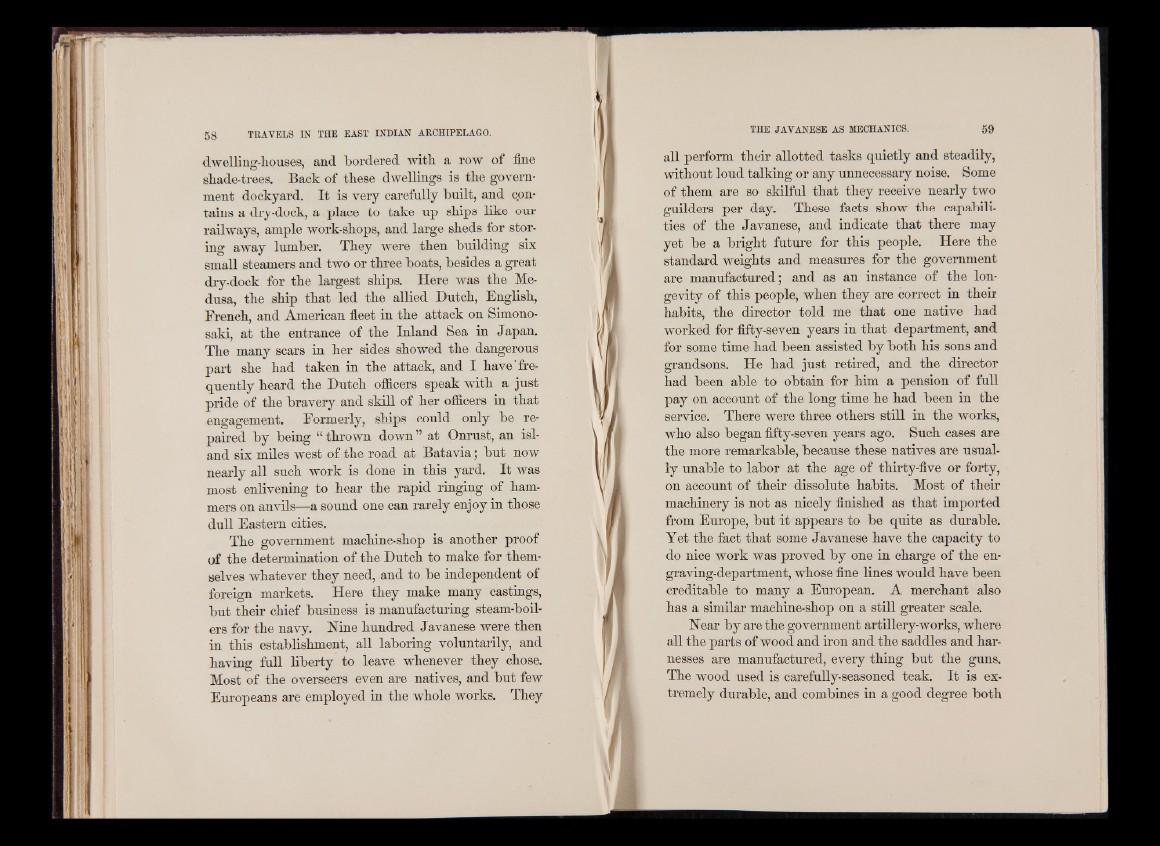
dwelling-houses, and bordered with a row of fine O '
shade-trees. Back of these dwellings is the government
dockyard. It is very carefully built, and contains
a dry-dock, a place to take up ships like our
railways, ample work-shops, and large sheds for storing
away lumber. They were then building six
small steamers and two or three boats, besides a great
dry-dock for the largest ships. Here was the Medusa,
the ship that led the allied Dutch, English,
French, and American fleet in the attack on Simono-
saki, at the entrance of the Inland Sea in Japan.
The many scars in her sides showed the dangerous
part she had taken in the attack, and I have‘frequently
heard the Dutch officers speak with a just
pride of the bravery and skill of her officers in that
engagement. Formerly, ships could only be repaired
by being “ thrown down ” at Onrust, an island
six miles west of the road at Batavia; but now
nearly all such work is done in this yard. It was
most enlivening to hear the rapid ringing of hammers
on anvils—a sound one can rarely enjoy in those
dull Eastern cities.
The government machine-shop is another proof
of the determination of the Dutch to make for themselves
whatever they need, and to be independent of
foreign markets. Here they make many castings,
but their chief business is manufacturing steam-boilers
for the navy. Nine hundred Javanese were then
in this establishment, all laboring voluntarily, and
having full liberty to leave whenever they chose.
Most of the overseers even are natives, and but few
Europeans are employed in the whole works. They
all perform their allotted tasks quietly and steadily,
without loud talking or any unnecessary noise. Some
of them are so skilful that they receive nearly two
guilders per day. These facts show the capabilities
of the Javanese, and indicate that there may
yet be a bright future for this people. Here the
standard weights and measures for the government
are manufactured; and as an instance of the longevity
of this people, when they are correct in their
habits, the director told me that one native had
worked for fiffcy-seven years in that department, and
for some time had been assisted by both his sons and
grandsons. He had just retired, and the director
had been able to obtain for him a pension of full
pay on account of the long time he had been in the
service. There were three others still in the works,
who also began fifty-seven years ago. Such cases are
the more remarkable, because these natives are usually
unable to labor at the age of thirty-five or forty,
on account of their dissolute habits. Most of their
machinery is not as nicely finished as that imported
from Europe, but it appears to be quite as durable.
Yet the fact that some Javanese have the capacity to
do nice work was proved by one in charge of the en-
graving-department, whose fine lines would have been
creditable to many a European. A merchant also
has a similar machine-shop on a still greater scale.
Near by are the government artillery-works, where
all the parts of wood and iron and the saddles and harnesses
are manufactured, every thing but the guns.
The wood used is carefully-seasoned teak. It is extremely
durable, and combines in a good degree both